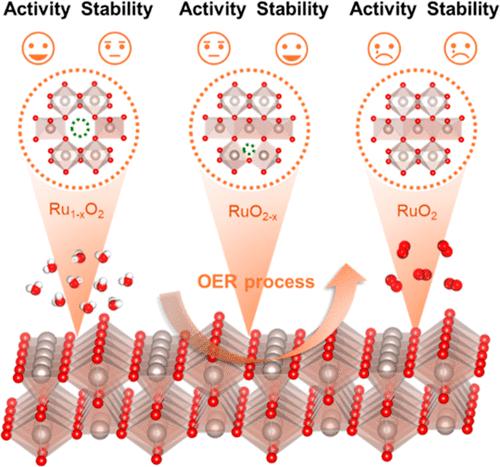Effect of Cation and Anion Vacancies in Ruthenium Oxide on the Activity and Stability of Acidic Oxygen Evolution
IF 11.3
1区 化学
Q1 CHEMISTRY, PHYSICAL
引用次数: 0
Abstract
Electrocatalysts capable of working efficiently in acidic media for the oxygen evolution reaction (OER) are highly demanded for the large-scale utilization of proton exchange membrane (PEM) water electrolysis. This study focuses on the design and fabrication of cation/oxygen vacancy-enriched RuO2 catalysts to investigate the impact of defect types on the OER activity and stability of RuO2. The comprehensive blend of experimental and theoretical approaches elucidates that the presence of Ru vacancies in Ru1–xO2 modulates the d-band center and optimizes the adsorption energy of the OER intermediates, thereby augmenting the intrinsic OER activity. Conversely, the presence of oxygen vacancies in RuO2-x diminishes the strength of Ru–O bonds, suppressing the involvement of the lattice oxygen oxidation mechanism (LOM) and Ru dissolution, consequently enhancing long-term stability. Notably, Ru1–xO2 exhibits the lowest overpotential of 212 mV at 10 mA cmgeo–2, while RuO2–x demonstrates superior stability, enduring 400 h under 10 mA cmgeo–2, surpassing many catalysts for acidic OER in the literature. Our findings demonstrate that defect engineering is a promising strategy to achieve electrocatalysts with super catalytic performance in acid media for water electrolysis.

氧化钌中的阳离子和阴离子空位对酸性氧发生活性和稳定性的影响
大规模利用质子交换膜(PEM)电解水对能够在酸性介质中高效进行氧进化反应(OER)的电催化剂有很高的要求。本研究侧重于阳离子/氧空位富集的 RuO2 催化剂的设计和制备,以探究缺陷类型对 RuO2 的 OER 活性和稳定性的影响。实验和理论方法的综合运用阐明了 Ru1-xO2 中 Ru 空位的存在可调节 d 带中心并优化 OER 中间产物的吸附能,从而增强其内在的 OER 活性。相反,RuO2-x 中氧空位的存在降低了 Ru-O 键的强度,抑制了晶格氧氧化机制(LOM)的参与和 Ru 的溶解,从而提高了长期稳定性。值得注意的是,在 10 mA cmgeo-2 条件下,Ru1-xO2 的过电位最低,仅为 212 mV,而 RuO2-x 则表现出卓越的稳定性,在 10 mA cmgeo-2 条件下可维持 400 小时,超过了文献中许多酸性 OER 催化剂。我们的研究结果表明,缺陷工程是实现电催化剂在酸性介质中电解水的超强催化性能的一种有前途的策略。
本文章由计算机程序翻译,如有差异,请以英文原文为准。
求助全文
约1分钟内获得全文
求助全文
来源期刊

ACS Catalysis
CHEMISTRY, PHYSICAL-
CiteScore
20.80
自引率
6.20%
发文量
1253
审稿时长
1.5 months
期刊介绍:
ACS Catalysis is an esteemed journal that publishes original research in the fields of heterogeneous catalysis, molecular catalysis, and biocatalysis. It offers broad coverage across diverse areas such as life sciences, organometallics and synthesis, photochemistry and electrochemistry, drug discovery and synthesis, materials science, environmental protection, polymer discovery and synthesis, and energy and fuels.
The scope of the journal is to showcase innovative work in various aspects of catalysis. This includes new reactions and novel synthetic approaches utilizing known catalysts, the discovery or modification of new catalysts, elucidation of catalytic mechanisms through cutting-edge investigations, practical enhancements of existing processes, as well as conceptual advances in the field. Contributions to ACS Catalysis can encompass both experimental and theoretical research focused on catalytic molecules, macromolecules, and materials that exhibit catalytic turnover.
 求助内容:
求助内容: 应助结果提醒方式:
应助结果提醒方式:


